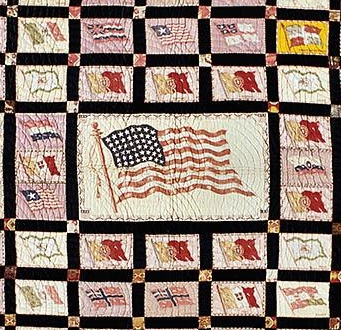Part i: Introduction; Part ii: 18th Century to Antebellum Era; Part iii: The Civil War & Postwar Era; Part iv: 1880s to 1920s; Part v: The Great Depression; Part vi: 20th Century and 1970s Revival; Part vii: 21st Century and Beyond
See also: North Carolina Quilts from the NCpedia Student Collection

The history of quiltmaking in North Carolina spans four centuries and has been shaped by Tar Heels of nearly every ethnic group and social class. At its simplest, quilting involves stitching or tying a layer of batting between two pieces of fabric. But makers’ differing resources, styles, and intentions have resulted in a vast diversity of expressions over the course of North Carolina’s history. Upper-class European settlers initially brought quiltmaking to the American colonies in the seventeenth and eighteenth centuries. Imported fabric cost dearly, and only women of means could afford the large pieces of silk and chintz used to create popular styles. Rather, most families used blankets or coverlets for warmth. Relative to other colonies, North Carolina did not develop a particularly rich quilting tradition during this early period. The region’s challenging geography slowed in-migration and did little to foster the growth of a large moneyed class. Even after statehood and through the antebellum period, the tenuous infrastructure, poor transportation, and overwhelming ruralness that contributed to North Carolina’s reputation as the “Rip Van Winkle State” also resulted in the creation of fewer quilts of exceptional artistry than in other parts of the young nation. Further, the South’s humid climate and abundant pests limited the survival rates of early textiles from that region, leaving scholars fewer examples to study and analyze.
North Carolina Quilts Audio Tour
The North Carolina Museum of History has recorded audio tours of a number of the quilts that are included with this article series. Visit this link to find and listen to the playlist.